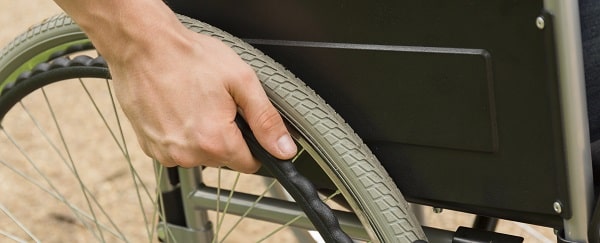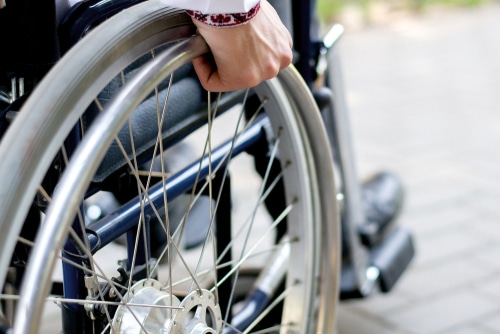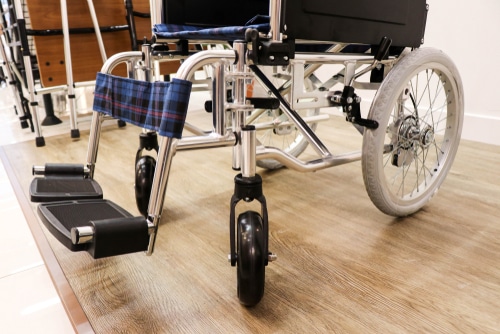Most wheelchairs come in standard dimensions and can hold an average of 100 to 125kg. But what happens if a person is heavier than that? Humans come in different shapes and sizes, and thankfully so do wheelchairs. Enter the bariatric wheelchair – a heavy duty wheelchair that can hold up to 270kg and has wider dimensions that standard chairs.
In this article we’ll look at what a bariatric chair is and what you should take into account before you choose one.
Table of contents

What is a bariatric wheelchair?
A bariatric wheelchair is a heavy duty wheelchair made to carry a larger person. Depending on make and model, it can hold 150kg to 270kg in weight and is heavier and wider than standard wheelchairs.
These chairs are often used by individuals who have a higher body weight, a mobility disability, are recovering from an injury and/or those who have recently had surgery.
These wheelchairs can come in a variety of different styles and designs, including manual and electric powered, as well as tilt-in-space and rehabilitation models. They’re usually heavier than standard wheelchairs due to their additional reinforcement and larger size.
Bariatric chairs aim to provide a safe and comfortable seating option for larger individuals and to meet the specific needs of bariatric patients (i.e. those being treated for obesity). They offer better stability and support and may reduce the risk of injury or infections.

What is the best wheelchair for a heavy person?
There are a number of different types of bariatric wheelchairs available in Australia. Some common options include:
Heavy-duty manual wheelchairs
These wheelchairs have reinforced frames and larger seat sizes to accommodate heavier people.
Electric bariatric wheelchairs
Electric wheelchairs are powered by a battery and are often used by individuals who have difficulty propelling a manual wheelchair. Many of the manufacturers make a heavy duty version with weight capacity of up to 270kg.
Tilt-in-space bariatric wheelchairs
These wheelchairs feature a tilt mechanism that allows the user to change the angle of the seat to improve their posture and comfort.
Rehabilitation bariatric wheelchairs
These wheelchairs are designed specifically for those recovering from an injury or illness. They often have adjustable components to allow various types of physical therapy.
How much does a bariatric wheelchair weigh?
This can vary depending on the specific model, size, and features of the chair. On average, a basic bariatric manual wheelchair can weigh around 18 to 22kg, while an electric model may weigh around 40 to 70kg and perhaps even more. Tilt-in-space and rehabilitation bariatric wheelchairs may also have weight added to them due to the extra components and features.
Remember that the weight limit of the chair is generally up to 270kg and the weight of the wheelchair itself is not as important as the weight it can support. It’s always a good idea to check the manufacturer’s specifications or with a healthcare professional to get an idea of the weight of a specific model of chair before making a buying or rental decision.
By the way, ever wondered when was the first wheelchair invented? We’ve got the answers, here.

What is the width?
The width of a bariatric wheelchair can vary based on the specific model and size. A standard bariatric wheelchair typically has a seat width of between 55 and 76cm. However, some special models can have seat widths of up to 90cm or more.
The width of the wheelchair is crucial when it comes to comfort and safety. It should be wide enough for the user to sit comfortably and not feel cramped, but also narrow enough to fit through doorways, halls and other tight spaces.
Can you hire one
There are a number of companies that provide disability equipment hire in Australia, including bariatric wheelchairs. Some of these companies may provide delivery and pickup services as well. You can find them through an online search or by asking your local health professional.
In addition to wheelchair rental companies, hospitals and rehabilitation centres may also have bariatric wheelchairs available for short-term rental for patients who are recovering from an injury or surgery.
Looking to transport your wheelchair via a vehicle that has little space? Take a look at how to choose mobility equipment trailers for car travel in Australia.

What to look for in a bariatric wheelchair
When buying a bariatric wheelchair, there are a number of factors that you should consider to ensure you get a model that’s safe, comfortable, and fits your needs. Some of the key factors to consider include:
Weight capacity
The most obvious factor is to check that the chair can carry your weight. Bariatric wheelchairs typically have a weight capacity of around 270kg. Never exceed the weight limit of a chair, as this could cause damage to the chair and you may get injured.
Seat width and depth
The width and depth of the seat should be large enough to provide a comfortable and stable seating surface.
Frame and material
Bariatric wheelchairs should have a reinforced frame and high-quality materials to ensure they can support extra weight and provide stability.
Adjustability
Look for a wheelchair with adjustable features, such as the backrest, seat height, footrests, and armrests, to ensure a perfect fit.
Wheel and tyre options
Bariatric wheelchairs often come with different wheel and tyre options, such as solid or pneumatic tires. Be sure to choose the option that best suits your needs and environment.

Transportation and storage
Consider carefully how you’ll transport and store the wheelchair. If you’ll be transporting it frequently or storing it in a small space, look for a wheelchair that’s easy to fold and has a compact design. Read our articles about:
- Mobility equipment storage and transport options
- Easy road tripping with your mobility equipment
- Lifts and hoists for converted vehicles
Type
Decide what type of wheelchair will meet your needs best. Electric, manual, tilt-in-space, rehabilitation and others have different features and benefits.
It’s always a good idea to consult with a healthcare professional, occupational therapist (read about occupational therapy wheelchair scripting) or specialised supplier to help you choose the right chair that fits your needs and budget. They can also help you with the fitting and adjusting of the wheelchair, ensuring that it fits comfortably and that you understand how to use it safely.
Insure your heavy duty wheelchair
Blue Badge Insurance specialises in covering mobility equipment like wheelchairs, mobility scooters and WAVs. We can cover a variety of unexpected costs, such as accidental damage and theft. Knowing you have insurance can give you peace of mind and make you feel more secure when using your wheelchair. Ultimately, it can save you money in the long run by covering the costs of unexpected repairs or replacements.
Why not get a quote today?








